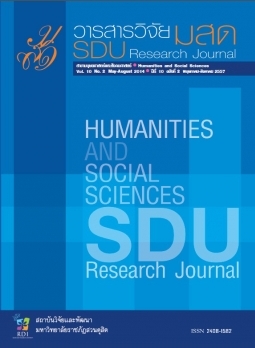Barhosts’ Narratives : Sexuality Phenomenon in the Thai Society
Keywords:
Barhost, sexuality, narative, Thai's storyAbstract
This research is a qualitative study aiming to tell the narratives and analysis on consumer culture, to consider on fighting and negotiation of femininity and masculinity as well as to indicate sexual relationship with a question, i.e., how did femininity and masculinity in the way of Barhost relate to sexuality and feminism under Social Constructivism Paradigm? Since sexuality is currently hidden with several social codes including norm issues, beliefs, and morality, persons who have different preference on sexuality regarding sexual behavior, sexual satisfaction, or sexual desire, became social defendants. The researcher obtained 9 persons with direct experiences to tell the narratives who created the meaning of this phenomenon that was the reflection of fighting and negotiation as well as to be consistent with sexual norm. It was found that Barhost and living was considered as negotiation with consumer culture, roles on creating personal identity by connecting with social identity whereas fighting and negotiation with femininity and masculinity was based on the norm defining the set of ethics via different interpretation and meaning.
The concept of feminism influenced on the roles of Barhost, i.e. although women were defined by the criteria and sexual knowledge to lack of bargaining power, Barhost was considered as a phenomenon building bargaining power against
sexual overwhelming authorizing higher power to men. The narrators proposed fighting and negotiation with this power via different methods.
A
References
Societies, 5(2), 1-22. Havanon, N. (2012). Kansang khwamchalatru ruang phet nai watthanatham boriphok. Bangkok: Mahidol University. Kaewthep, K & Sae-kuay, P. (2004). Phetwiti wanwarn wanni ley wanprungni theejamaimearnderm. Bangkok:
Women’s Studies Center. Kuenkaew, A. (2013). Wattanatam chay pen yai. Retrieved March 30, 2013, from http://muslimchiangmai.net/ index. Parker, R. G. H., & Carballo, M. (1999). Sexual Culture, HIV Transmission, and AIDS Research. In R. Parker & P. Aggleton (Eds.), Culture, Society and Health: A
Reader. London: UCL Press. Pongsapich, A. (2005). Gender roles and sexuality of women in Thai society. Bangkok: Chulalongkorn University Printing House, Bangkok. Tan, M. L. (2005). Talking Sex: Anthropological Narrative in Sexuality Research. In the Southeast Asian Consortium on Gender, Sexuality and Health (Ed.), Researching Sexuality and Sexual Health in Southeast Asia and China (2th ed., pp. 3-16). Thailand: The Southeast Asian Consortium on Gender, Sexuality, and Health. Vance, C. (1999). Anthropology Rediscovers Sexuality: A Theoretical Comments. In R. Parker & P. Aggleton (Eds.), Culture, Society and Sexuality: A Reader (pp.3954). London: UCLA Press.







